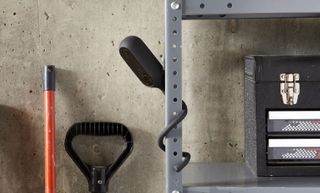Canary's New Flex Cam Outdoes Nest with 4G LTE
Canary's new Flex model can be placed indoors or outdoors, and run on a power cable or on batteries.
It's waterproof, can be powered by a cord or by rechargeable batteries, and has optional accessories that let you stake it into the ground, twist it around a pole or lock it into place. Another accessory will connect the camera to the Internet via a cellular LTE connection instead of via Wi-Fi.
Canary has announced its first indoor/outdoor camera, the $199 Canary Flex, which will be available in mid-October.

Canary has also updated its subscription plans. Under the new scheme, a Canary membership will start at $10 per month for 30 days of video history, and will also include telephone-based incident support and a guarantee of paying up to $1,000 for a customer's home-insurance deductible for burglaries and other home-related incidents.
MORE: Best Wireless Home Security Cameras
That's a significant markdown from Canary's current subscription plans, which run from $5 per month for two days of video history to $30 per month for 30 days. It's also less than Nest Labs' Nest Aware subscription, which maxes out at $30 per month for 30 days of video history. Users will be able to add extra Canary cameras to the subscription for $5 each (although the third is free), compared to $15 for each extra Nest camera.
The Flex has night vision, motion detection and a 116-degree wide-angle lens. At 8 ounces and 4.35 inches tall, it's a good deal smaller than the original Canary, which will still be sold and supported. It connects via dual-band a/b/g/n Wi-Fi as well as Bluetooth Low Energy.
The camera has a speaker and a microphone, but two-way intercom function will have to wait for a software update. The video resolution is "HD" — we asked a Canary representative and were told that this means 720p, instead of the original Canary's 1080p resolution, for "optimal streaming." The new camera also lacks the original's temperature, humidity and air-quality sensors.
Sign up to get the BEST of Tom’s Guide direct to your inbox.
Upgrade your life with a daily dose of the biggest tech news, lifestyle hacks and our curated analysis. Be the first to know about cutting-edge gadgets and the hottest deals.

The camera's outdoor operating temperatures range from 14 degrees to 113 degrees Fahrenheit (-10 to 45 Celsius), which is fine for most of the continental United States but might be dicey for some northern states, the desert Southwest and the Canadian prairie.
A Canary representative told us that the rechargeable batteries will last about four months on a charge. Users have the option of plugging in the Flex to an outdoor outlet as well.
During a hands-on with the Flex earlier this month, we were impressed by the camera's small size and appealing design. But the most interesting feature was the forthcoming 4G LTE mount, which connects the camera's feed to Verizon's cellular-data network instead of to local Wi-Fi.

With that accessory, the Canary Flex's range increases to the far corners of a ranch, for example, or to vacation homes or recreational boats. Pricing and availability for the 4G LTE mount have yet to be determined.
Until recently, Netgear's Arlo was the premier outdoor Wi-Fi security camera. But Nest brought its own outdoor camera, the Nest Cam Outdoor, to market earlier this month. Netgear itself will be updating its Arlo outdoor line this fall, and other security-camera makers may follow suit.
We're expecting a review unit of the Canary Flex soon. Stay tuned for our full review.
Paul Wagenseil is a senior editor at Tom's Guide focused on security and privacy. He has also been a dishwasher, fry cook, long-haul driver, code monkey and video editor. He's been rooting around in the information-security space for more than 15 years at FoxNews.com, SecurityNewsDaily, TechNewsDaily and Tom's Guide, has presented talks at the ShmooCon, DerbyCon and BSides Las Vegas hacker conferences, shown up in random TV news spots and even moderated a panel discussion at the CEDIA home-technology conference. You can follow his rants on Twitter at @snd_wagenseil.

